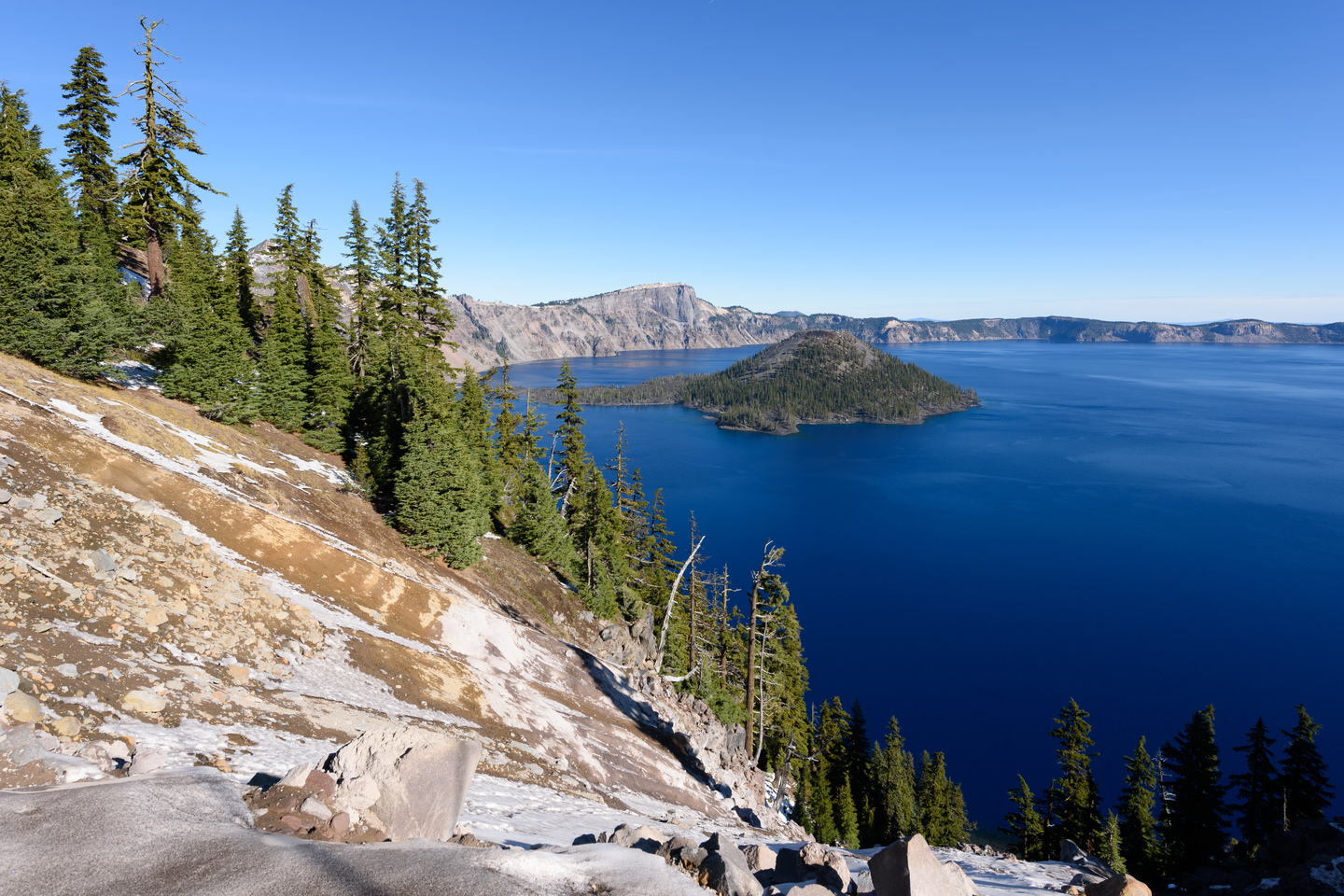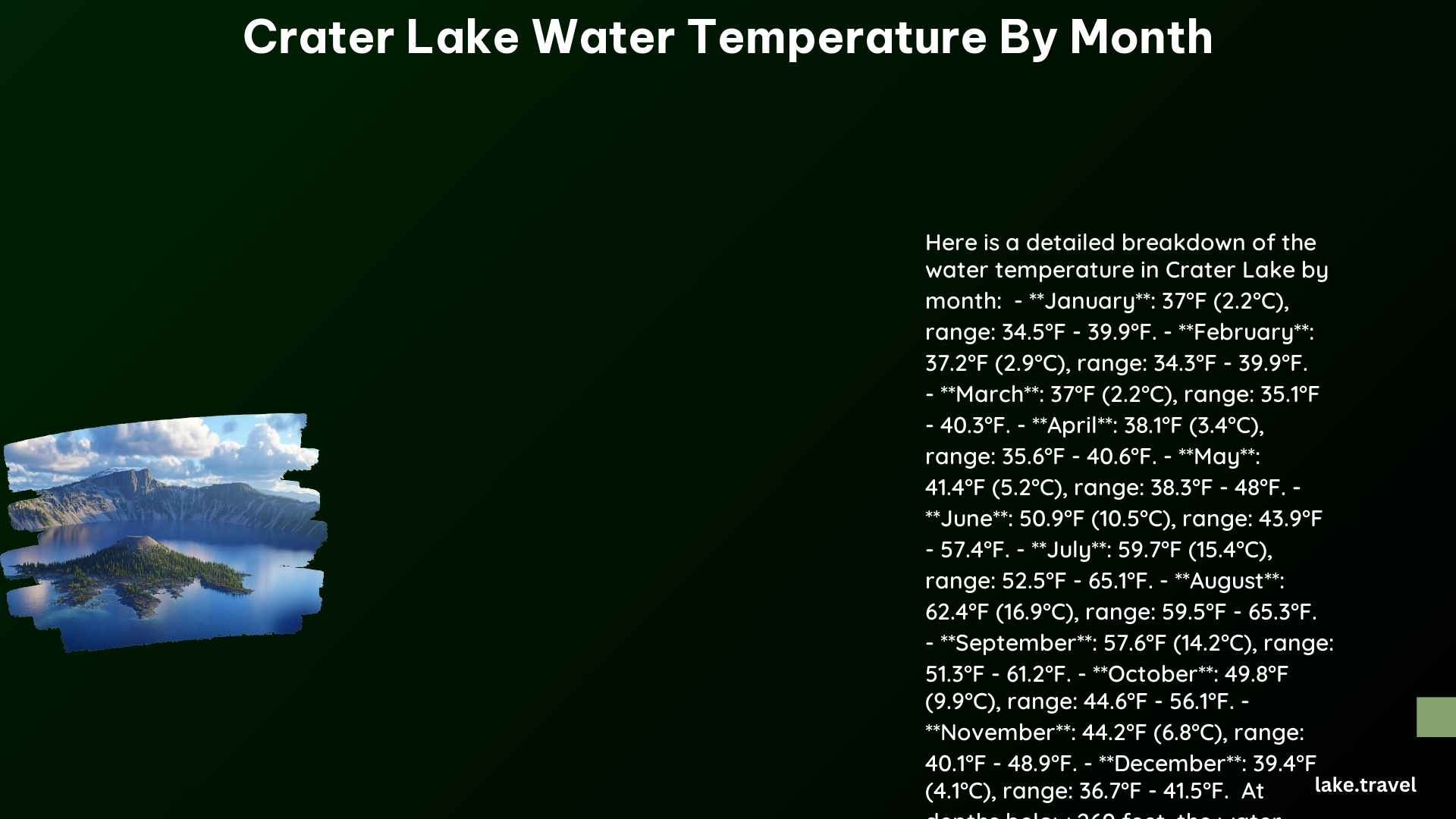Crater Lake’s water temperature varies significantly throughout the year, impacting visitor activities and experiences. This comprehensive guide explores the monthly temperature fluctuations, ranging from a chilly 37°F in winter to a more comfortable 62°F in summer. Understanding these temperature changes is crucial for planning your visit, whether you’re considering a refreshing swim or simply admiring the lake’s pristine beauty from the shore.
What Are the Average Water Temperatures in Crater Lake Throughout the Year?

Crater Lake’s water temperature fluctuates throughout the year, influenced by seasonal changes and environmental factors. Here’s a breakdown of the average temperatures by month:
| Month | Average Temperature (°F) | Average Temperature (°C) |
|---|---|---|
| January | 37.0 | 2.78 |
| February | 37.2 | 2.90 |
| March | 38.5 | 3.61 |
| April | 40.1 | 4.50 |
| May | 44.6 | 7.00 |
| June | 50.9 | 10.50 |
| July | 58.1 | 14.50 |
| August | 62.4 | 16.90 |
| September | 57.6 | 14.20 |
| October | 51.8 | 11.00 |
| November | 45.5 | 7.50 |
| December | 40.1 | 4.50 |
How Do Winter Temperatures Affect Crater Lake Activities?

January and February: The Coldest Months
During January and February, Crater Lake experiences its coldest water temperatures, averaging around 37°F (2.8°C). These frigid conditions significantly impact visitor activities:
- Swimming is strongly discouraged due to the extreme cold.
- The risk of hypothermia is at its highest.
- The lake rarely freezes, but surrounding areas are often covered in snow.
- Winter activities like snowshoeing and cross-country skiing become popular alternatives.
- Many park facilities have limited access or are closed.
Despite the cold, the winter landscape offers breathtaking views of the snow-covered caldera, attracting photographers and winter sports enthusiasts.
What Changes Occur in Crater Lake’s Water Temperature During Spring?
March to May: The Thawing Period
As spring arrives, Crater Lake’s water temperature gradually increases:
- March: 38.5°F (3.61°C)
- April: 40.1°F (4.50°C)
- May: 44.6°F (7.00°C)
This warming trend brings about several changes:
- Snow begins to melt, improving access to the lake.
- The Rim Drive starts to open, offering more viewpoints of the lake.
- Swimming is still not recommended due to the cold water.
- Hiking trails around the lake become more accessible as snow recedes.
- Wildlife activity increases, enhancing visitor experiences.
When Does Crater Lake Become Suitable for Swimming?
June to August: Peak Swimming Season
The summer months see Crater Lake’s water temperature reach its annual peak:
- June: 50.9°F (10.50°C)
- July: 58.1°F (14.50°C)
- August: 62.4°F (16.90°C)
August offers the most comfortable swimming conditions, but even then, the water remains quite cold. Here’s what visitors should know:
- The Cleetwood Cove Trail, the only legal access to the lake for swimming, opens in late June or early July.
- Swimmers should be prepared for cold water shock, even in August.
- No wetsuits are typically needed for brief swims, but they can enhance comfort and safety.
- The lake’s clarity is at its best, offering incredible underwater visibility.
- Boat tours operate during this period, providing alternative ways to experience the lake.
How Does Fall Affect Crater Lake’s Water Temperature?
September to November: Cooling Down
As autumn sets in, Crater Lake’s water temperature begins to decline:
- September: 57.6°F (14.20°C)
- October: 51.8°F (11.00°C)
- November: 45.5°F (7.50°C)
This cooling trend impacts visitor activities in several ways:
- Swimming becomes increasingly challenging and risky.
- The Cleetwood Cove Trail typically closes by mid-September.
- Fall colors around the lake create stunning photo opportunities.
- Boat tours and other water-based activities wind down for the season.
- Hiking remains popular, but visitors should prepare for cooler temperatures.
What Safety Precautions Should Visitors Take When Swimming in Crater Lake?
Regardless of the month, swimming in Crater Lake requires caution:
- Always check current water temperatures and weather conditions before swimming.
- Be aware of the signs of hypothermia and cold water shock.
- Swim only in designated areas, such as near the bottom of Cleetwood Cove Trail.
- Never dive into the lake, as hidden rocks can pose dangers.
- Inform others of your swimming plans and never swim alone.
- Consider using a personal flotation device for added safety.
- Limit swim time to avoid prolonged exposure to cold water.
How Does Crater Lake’s Water Temperature Compare to Other Lakes?
Crater Lake’s unique characteristics set it apart from many other lakes:
- Its high altitude (6,178 feet above sea level) contributes to colder temperatures.
- The lake’s depth (1,943 feet) helps maintain consistently cold temperatures year-round.
- Unlike shallower lakes, Crater Lake doesn’t experience significant warming in its deeper parts.
- Compared to coastal lakes at similar latitudes, Crater Lake remains much colder throughout the year.
- The lake’s isolation from external water sources helps maintain its pristine, cold nature.
Understanding these factors helps visitors appreciate the unique ecosystem of Crater Lake and plan their activities accordingly.
What Are the Best Months to Visit Crater Lake for Different Activities?
Depending on your interests, certain months are more suitable for specific activities:
- Swimming: Late July to early September
- Hiking: June to October
- Scenic drives: July to October (when Rim Drive is fully open)
- Winter sports: December to March
- Photography: Year-round, with each season offering unique perspectives
- Boat tours: July to mid-September
- Stargazing: Best on clear nights, particularly in summer and early fall
By aligning your visit with your preferred activities, you can make the most of Crater Lake’s varying conditions throughout the year.
Understanding Crater Lake’s water temperature by month is crucial for planning a safe and enjoyable visit. Whether you’re an avid swimmer braving the cold waters or a nature enthusiast admiring the lake’s beauty from the shore, knowing what to expect can enhance your experience at this natural wonder. Remember to always prioritize safety and respect the unique ecosystem of Crater Lake National Park.
References:
1. Swimming – Crater Lake Institute – Enhancing the Visitors Experience
2. Water Temperature in Crater Lake, United States
3. Weather – Crater Lake National Park (U.S. National Park Service)
